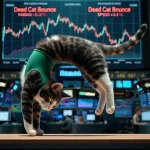Chris Martenson: Bullseye or Bust?
April 10, 2025
The Oracle Dilemma: Apocalypse or Insight?
Chris Martenson doesn’t deal in quiet forecasts. He deals in systemic tremors, societal fault lines, and collapse as both a financial and a civilizational inevitability. You don’t just consume his predictions—you internalize them like a countdown clock, each tick pulsing with dread and anticipation.
But this essay isn’t a trial. It’s not binary: right or wrong, prophet or crank. It’s something deeper, stranger—less Newtonian, more quantum. In the world Martenson sketches, the observer changes the outcome. If you believe collapse is coming, your behaviors might shape its arc. If you prepare for scarcity, you might outlive the abundance crowd.
So, was Martenson accurate? That depends on how you define accuracy: is it timing, trajectory, or tonality? Was he early? Maybe. Was he directionally right? Often. Did he overshoot? But in the fog of financial warfare, sometimes being vaguely right is more dangerous than being precisely wrong.
Crash Course Vectors: Mapping the Fear Field
His seminal work, “The Crash Course,” wasn’t just content—it was conditioning. A series of elegantly terrifying chapters linking energy depletion, exponential debt, ecological overshoot, and the fragility of civilization. It wasn’t predictive like a weather report. It was more like psychological priming wrapped in data. Once you watched it, you never looked at GDP the same again.
But here’s the twist: the crash he predicted didn’t come all at once. No singular “end event.” Instead, the world frayed at the edges. Local collapses. Global inflation. Energy crunches. Banking fragilities. Supply chain seizures. As if his vision unfolded like a slow-motion detonation. Not boom—but bleed.
So was the prediction wrong? Or was it scalar—playing out on timelines and layers too complex for linear minds?
Martenson vs. Time: When Early Looks Like Wrong
Here’s the thing about early warnings: they age badly in real time. They look like paranoia until they don’t. Martenson talked peak oil when frackers were still partying. He warned about pandemic fragility in 2018. He flagged systemic risks in shadow banking and central bank overreach before they were headline material.
Some of his timing was off, but the shape of the story kept curling back into relevance. The 2020 pandemic vindicated his biology background and his systems thinking. His call for energy scarcity was back in play once the Russia-Ukraine conflict yanked commodity flows like vital arteries. His skepticism of “forever printing” was validated by the inflation spikes that followed COVID-era QE.
He wasn’t wrong. He was out of sync with the tempo most investors need to stay solvent.
Systemic Thinking in a Linear World
Wall Street is addicted to quarter-over-quarter logic. It punishes ambiguity, delays, and non-binary narratives. But Martenson’s worldview isn’t a quarterly earnings model. It’s a planetary distress signal transmitted in fractals. He ties together biology, geology, finance, psychology, and thermodynamics—not to be clever, but because he sees collapse not as an event, but as emergence.
He’s not forecasting the market. He’s interpreting symptoms of civilizational entropy.
The problem? That kind of framing doesn’t trade well. You can’t time ETFs on a civilization-scale thesis. You can’t hedge entropy. So traders mock it. Investors dismiss it. But preppers? They eat it up.
And here’s where Martenson splits audiences: to the market crowd, he’s alarmist. To those watching groundwater disappear and soil erode? He’s grounded in realism.
Prediction or Projection? The Mirror of the Message
Here’s the uncomfortable layer. Some of Martenson’s forecasts aren’t just based on data—they’re projections of psyche. The world he paints isn’t just probable—it’s personal. A deep mistrust of institutions. A reverence for biology. A longing for localism. His predictions often reflect his temperament: measured and cautious but woven with existential alarm.
Does this invalidate them? No. But it means we must read them not as oracle-speak but as vector fields—emergent from values, bias, fear, and insight all tangled together.
His call for economic collapse isn’t just an external model—it’s a psychic reflection of collapse already underway: trust in media, governments, and currencies. What he senses isn’t just macro fragility—it’s meaning fragility.
? Chris Martenson Prediction Tracker: Insight or Illusion?
| Prediction | Verdict | Commentary |
|---|---|---|
| Peak Oil (2008–2012) | Early Hit | Right conceptually; premature timing. Shale delayed it, but energy fragility resurfaces now. |
| Housing Market Collapse (Pre-2008) | Direct Hit | Nailed systemic risk and subprime unraveling before the crash went mainstream. |
| Exponential Debt = Collapse | Slow Burn Truth | Collapse didn’t explode—but debt saturation is visibly eating real growth. Unsustainable long-term. |
| The Crash Course (2008+) Macro Collapse Framework | Emergent Validity | A slow-motion accuracy. Not wrong—just unfolding in fragments, globally uneven. |
| Food & Water Scarcity | Emerging Alarm | Data confirms degradation, but market hasn’t priced it in yet. Time bomb still ticking. |
| Gold to Explode to $5000+ | Overshoot Miss | Too extreme. Right direction in crises, but failed to reach anywhere near projections. |
| Silver to Moon | Hopeium Spike | Repeated wrong timing. Spikes occur but never sustain. Over-reliance on monetary collapse thesis. |
| Collapse of Fiat Currencies | Overstated (Yet) | Inflation yes, collapse no. Fiat still rules, though structurally brittle. |
| Skepticism of Bitcoin (early years) | Major Miss | Dismissed too early. Missed the paradigm shift and the ideological overlap with decentralization. |
| Institutional Failure During Pandemics | Massive Hit | Was ahead of the curve on systemic fragility and unpreparedness. 2020 vindicated this hard. |
| Supply Chain Fragility | Direct Hit | Clear call, pre-COVID. He flagged the risk while Wall Street ignored it. |
| Collapse of Trust in Central Banks | Medium Hit | Trust erosion is real, but not total. Still early innings of faith decay. |
| Localism as Survival Strategy | Cultural Edge Hit | Not a financial return play, but socially and strategically ahead of its time. |
| Civil Unrest as Economic Feedback Loop | Real-Time Hit | We’re seeing this now: inflation + inequality + distrust = systemic pressure. |
False Positives or Warning Shots?
Let’s track some hits, misses, and “truths in the wrong outfit”:
- Peak oil: This was overstated in terms of timing, but it is resurgent in a geopolitical energy war era. Was he wrong? Or just misaligned with shale’s temporary distortion?
- Pandemic readiness: Clear hit. Called out fragility of global systems, failure of supply chains, and institutional incompetence—long before 2020.
- Monetary collapse: This hasn’t happened in the Weimar sense. But inflation ripped into reality, central banks lost credibility, and asset bubbles are twitchy. Is this a collapse of one event or an ongoing degradation of monetary trust?
- Gold and silver moonshots: Mixed record. Some cycles are right, and others are mistimed. It’s not a permabull, but it’s prone to overshooting in crisis scenarios.
- Bitcoin: Skeptical early. Has warmed, but missed the alpha wave.
- Food and water scarcity: Still unfolding. Not headline yet—but the data on aquifers, topsoil, and climate shifts support the thesis.
Conclusion? Martenson’s track record isn’t clean. But it’s resonant. He’s not your guy for 6-month options. He’s the guy you listen to when the lights flicker and the banks freeze withdrawals.
Why Traders Hate Him and Thinkers Can’t Ignore Him
Martenson threatens the sacred cows of finance:
- Infinite growth
- Fiat permanence
- Technological saviorism
- Linear progress
His worldview doesn’t allow for happy endings or V-shaped recoveries. That’s uncomfortable in a world addicted to optimism as a performance asset. But that discomfort is precisely why he remains relevant. He’s not trying to win quarterly. He’s trying to survive decadeally.
And if you believe in cycles—Fourth Turning, Kondratieff waves, long-term debt supercycles—then Martenson is just one waveform in a broader frequency. He doesn’t always hit the timing. But he tunes into the background noise that most can’t hear.
Martenson’s Real Value: Metaphor Over Metrics
If you want to get rich from Martenson’s work, you’re reading him wrong. His value isn’t alpha generation. It’s mental model expansion. He makes you see debt differently. Time differently. Civilization differently.
He isn’t trading trendlines—he’s diagramming systemic tension. His real edge is metaphor: the idea of the economy as a living system, growth as a tumour, central banks as addiction cycles. That metaphor, more than any chart, is what sticks.
Because once you see the world through Martenson’s frame, you can’t unsee it. That alone makes him dangerous—and indispensable.
The Utility of Collapse Narratives
Collapse sells. So yes, there’s an incentive. The attention economy rewards alarm. But that doesn’t mean it’s fake. It means it’s filtered. What Martenson offers is less forecast than focal point. He gives anxious minds a narrative to hold onto. That’s not fraud. That’s psychological infrastructure in a world breaking down.
And it’s easy to dismiss him if you’re sitting on S&P gains. Harder when you’re watching real wages flatline, savings evaporate, and systems buckle under their complexity.
You don’t have to agree with him to use him. You use Martenson like you’d use Taleb: not as gospel, but as a counterweight to hubris.
Where to Place the Martenson Bet
If you believe Martenson, you don’t go all in on collapse. You hedge against systemic instability. You own:
- Real assets: farmland, hard commodities
- Decentralized money: Bitcoin, privacy tech
- Skills: gardening, medicine, off-grid power
- Community: localism over globalization
You don’t need him to be right to benefit. You just need the system to stay chaotic long enough for the edges to outperform the center.
Martenson doesn’t promise safety. He invites you to think like a node in a failing network. That alone is alpha in an overleveraged world.
Decoding the Unseen















